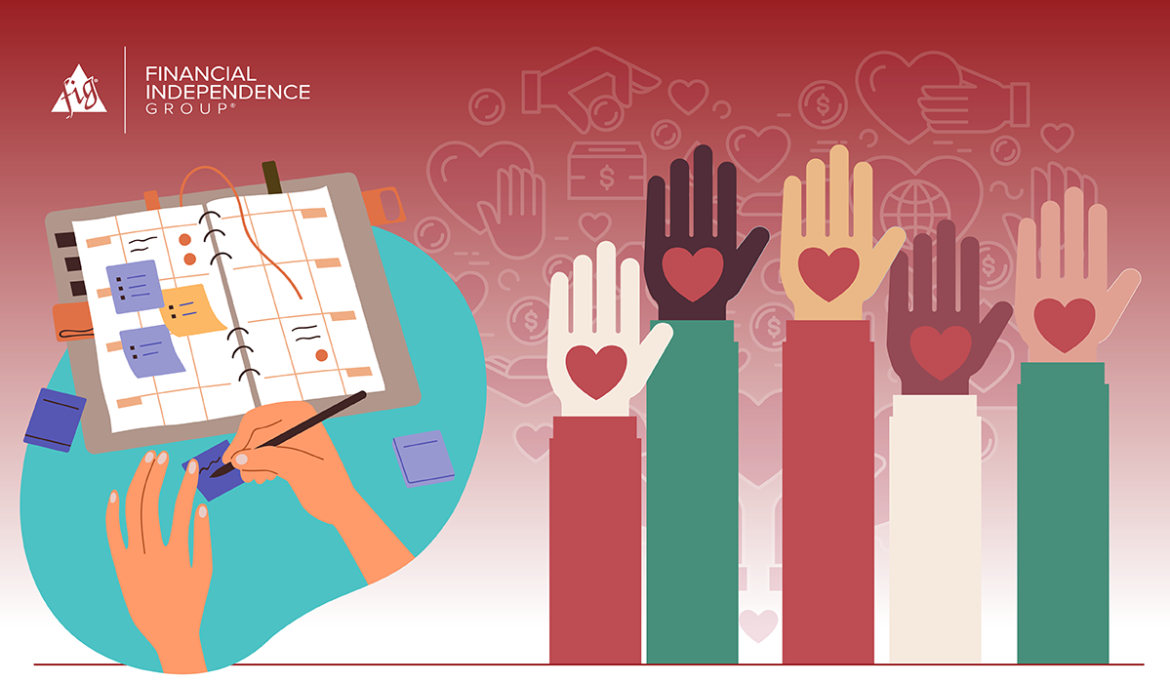Updated September 25, 2023, at 3:14 PM
For financial advisors, planning for and putting on charitable events are a fantastic way to build a reputation in your area and engage with your clients and community members. First and foremost, charity events allow your firm to give back to the community and support a good cause. They can also be a source of great public relations and free local media coverage.
Charity events help you to form stronger bonds with clients and potential referrals through an important cause and a shared experience. By showing your clients your passion for philanthropy, you’ll help them get to know you as a person and not just as their advisor.
Our experience shows that clients who develop a personal relationship with their advisor are happier, more satisfied, and less likely to leave.
Finally, planning charitable events allow you to market your firm without spending your own money. While these events require time, energy, and upfront investment, the revenue you take in from the event will cover the costs and the net proceeds will go to the charity as a donation.
Consider the following planning steps and helpful tips for each stage of your process to guide your charity event planning.
How to Start Planning a Charity Event
Start planning far in advance of your desired event date. Ideally, give yourself at least six to nine months to give your team plenty of time to work through the planning for your charitable event. Think carefully about your internal and external goals for a charity event. Then, meet with key staff to discuss what you want to accomplish.
Your main objective should be to support a great cause in your community, but it’s also important to think about the outcomes you want to achieve for your practice, such as:
- Who’s your target audience for your event?
- Do you want to bring together a group of your best clients and their friends?
- Do you want to get media coverage for your charity event?
- Do you want to establish relationships with centers of influence in your community?
- Do you want to expand your use of social media through this charity event?
Think about what charities and causes would benefit from a fundraiser. Don’t just arbitrarily pick a charity; dig deeply into your own interests and values.
What causes are close to your heart? Cancer research? Animal welfare? Hunger? Education? Having a personal connection to the cause is compelling and will help your clients and their friends understand why they should get behind it. Another savvy choice would be a cause that’s connected to the philanthropic efforts of a target group of clients.
It’s important to be confident that the charity to which you’re donating the proceeds of your event is entirely above board. Charity Navigator and Guidestar are online services that you can use to check out the legitimacy of an organization.
We recommend choosing a charity that’s:
- Local to show you’re connected to your community
- Close to your heart so it reflects who you are as a person
- Reputable, so your donations are used effectively and responsibly
Choosing a Charity Event
What do you enjoy doing? Whether it’s golfing, walking, running, cinema, auctions, food, music, or dancing—any activity that you can sell tickets to or pay to perform can become a charity event. The key is profitability. Great charitable events are fun, profitable, and simple to execute.
When brainstorming for event ideas, ask yourself the following questions:
- What are the costs associated with the event? (Think of the venue, activity, refreshments, promotional items, invitations, and advertisements.)
- What can I sell to bring in revenue? (Think about tickets, VIP tickets, raffles, a silent auction, or refreshments.)
- How much profit will be left over as a donation to my charity? (Always overestimate costs and underestimate revenues to leave a margin for error.)

Budgeting accurately for an event is one of the single most important aspects of planning a successful charity event. Ultimately, your goal is to contribute to a great cause. If you don’t budget effectively, or let costs spiral out of control, your event will fail to be profitable, which will erode your credibility with the charity and even your clients.
Related: 12 Habits That Build a Killer Client Appreciation Program
Keep Your Charity Event Planning Simple at First
If this is your first time organizing a charity event, we strongly recommend that you keep things simple. Don’t make your first, second, or even third event a large affair. Instead, focus on simplicity by leveraging an existing event and bringing your clients.
For example, you could purchase a table at a charity gala, or captain a team for a charity walk. You could also organize a group of clients and friends to work a Saturday morning for Habitat for Humanity or serve food at a soup kitchen.
Take them out to lunch afterward and you have a great charity event with very little planning. Bring along a staff member to photograph participants and post them to social media (with permission).
Organizing Steps to Take When Planning a Charity Event
Don’t be overwhelmed by the idea of planning a charity event. Instead, be sure to leverage a client planning committee, community partners, and the charity’s resources to take most of the burden off your plate.
Step 1: Internal Planning
Take a look at your internal resources and determine how much time and energy you can afford to devote to an event. You’ll need at least one staff member who can take point on planning and be the single point of contact. While you, the advisor, will need to chair the planning committee, you definitely don’t want to take on the major organizational tasks.
Think carefully about all the pieces of your event and define tasks and roles that’ll need to be assigned. Does your event seem to be too complicated? Scale it back and keep it simple.
Another critical task you should complete early on is to create a detailed budget for your event that includes estimated expenses and sources of revenue. In the initial stages of planning, it’s a much better idea to overestimate expenses and underestimate revenue so that you leave a margin for error. As you get deeper into the planning, you’ll have a better idea of your actual expenses and where your sources of revenue will be.
Budgeting accurately is important; you certainly don’t want to find yourself in the hole for your event and you’ll have a much better reception from your charity if you can approach them with a well-conceived budget in hand.
Step 2: Create a Charity Event Planning Committee
Your clients are your best assets when planning a charity event. Not only will they be your attendees, but they’ll also be a part of your planning committee and event volunteers. Reach out to between five and ten clients and invite them to be on your event committee. A good script that you can use over the phone might be:
I’ve been presented with the opportunity to support a really great cause! As you know, the [charity’s name] is a charity very close to my heart, and it may be close to yours as well. They’re going to be hosting a golf tournament at the end of this year and we’re planning on participating. As I am sure you can imagine, an event like this will take a good deal of planning and my staff won’t be able to do it alone. Would you be interested in being a part of our planning committee for this event?
Effective charity event planning committee members often are:
- Great clients
- Retired or working part-time
- Have business or organizational experience
- Love philanthropy and community engagement
- Well connected and excited about the event
It’s important to fit clients into the right roles on your charity event planning committee and to ask them for their input into how to make the event a great success. If a client has extensive business or financial experience, they could be in charge of event finances. If a client is naturally extroverted and well connected, perhaps they could be in charge of organizing volunteers or soliciting donations.
Depending on the size of your event (get advice from charity staff or a committee member with experience), you’ll need between 10-30 volunteers to run the event. If, for example, your event is large and requires several teams of volunteers, to take care of parking, concessions, sign-up, and other areas, it’s a good idea to put a committee member in charge of each section. They can recruit friends to volunteer and assist them.
You’ll need to host several planning meetings at your office to keep everyone’s mind on creating a great event. Since you’ll be working with some of your best clients, offer dinner or refreshments, but don’t allow the meetings to be sidetracked by too much socializing.
A possible meeting schedule might look like this:
- Meeting #1: Present the event with a budget and fundraising goals, brainstorm ideas, and assign responsibilities and deadlines
- Meeting #2: Give progress reports and address any issues
- Meeting #3: Go over final details, conduct a walk-through, and confirm event assignments
- Meeting #4: Host a post-event party for clients and volunteers to give thanks and present the donation
Step 3: Leverage the Charity’s Resources

Meet with your chosen organization early in the planning process to ask for their logistical support. What can they offer you in exchange for your fundraising? What advice do they have for successful events? Charities are typically great at getting media coverage and drafting press releases or other information about the event.
The charity can also help educate your staff and planning committee about the cause. Get a commitment in writing that includes assigned staff and deadlines so that your assistant can get progress reports.
When you meet with the charity, bring a detailed budget so that they know you have a good grasp of your estimated costs and will be able to make a significant donation. You’ll be much more likely to get their help and attention if you can show them that your event will be a success.
Step 4: Get Local Media Coverage for Your Charity Event
Creating a media strategy is key to getting some marketing results out of your charity event. Ask your charity for assistance in developing a press release and contacting the local media.
There are many ways to get local media interested in your event. If you (or a member of your charity event planning committee) have media contacts, reach out to let them know about the event. You can also contact columnists or reporters who cover local events with a well-researched pitch.
The media loves unusual facts, personal anecdotes, emotional draws, and statistics. Work with your charity to develop an interesting hook and make it more likely that your event will get good coverage.
If you do make a media pitch, make sure it includes:
- Who’s planning the event and for which charity or cause
- Why this cause is important to the community
- What your fundraising goal is
- How a donation will help the cause
- Other people or organizations involved in the event
- When the event will occur
- What people can do to help
- Where to find more information
Related: Giving Back Through Business: Why You Should Consider Planned Philanthropy
Step 5: Build Connections with Local Businesses
One of the best ways to limit your costs and raise more money for your charitable event is to seek out other sponsors. This is also a great way to connect with local centers of influence and prominent businesses with whom you’d like to form a relationship.
You can ask for monetary contributions or in-kind donations in the form of prizes, food, or an activity in the event. This allows them to contribute to a great cause and get their business in front of an affluent group of participants.
Depending on the size of your charity event, you can also ask your co-sponsors (particularly attorneys, CPAs, and other potential referral partners) to invite some of their own clients to the event. Remember, as the primary sponsor, your logo will be most prominent; giving you the opportunity to market your firm to a new group of prospects.
Step 6: Executing Your Charity Event
Every event is different in size, scope, and complexity, but there are a few key tips to making your big day a success:
- Conduct a walk-through with your committee, staff, and vendors to familiarize yourselves with the site and address any issues.
- Make sure that everyone is clear on their event responsibilities and knows where to be at what time.
- Show up early on the day of the event with your staff.
- Be humble, focused on the cause, and genuine with everyone you meet. Draw people to you with your commitment to philanthropy and leave self-promotion for another occasion.
Step 7: Charity Event Wrap-Up
Your work doesn’t stop when the day is over. After the event, you’ll need to work with your committee to total up revenue and expenses, pay any remaining vendors, and send final donations to the charity.
Host a wrap-up party for committee members, volunteers, and other sponsors to give them your personal thanks for their hard work and contributions. We also recommend meeting with your staff and the charity event planning committee to get their feedback on the event.
In your event wrap-up discussions, consider the following:
- Did you meet your internal and external objectives?
- Would you put on this charity event again?
- What went well with the charity event?
- What could have been improved?
- What recommendations do you have for future charity events?
Step 8: Follow-Up After Your Charity Event
Make sure that you keep in touch with the charity and find out how your donation was used. Did they build something new? Did they help a specific group of people?
Even if you don’t have a lot of details, reach out to your clients, volunteers, and attendees afterward to let them know how their contributions helped the cause. If possible, include some photos to show them their donations in action.
Parting Words
Charity events are a great way to invest in your community, build strong bonds with your best clients, and promote your business without spending a lot of money. They can also be complex projects that take up a lot of time and resources. We strongly recommend that you keep your events simple at the beginning and use external resources to reduce the planning load on your staff.
Starting small and focusing on doing a great job for the charity will help make your charitable events a great success.


